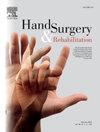Flexor tendon repair in zone II of the hand: Evidence-based management
IF 1
4区 医学
Q4 ORTHOPEDICS
引用次数: 0
Abstract
Introduction
Flexor tendon injuries require precise surgical repair followed by rehabilitation to ensure optimal recovery and reduce the risk of complications such as tendon rupture, scarring and adhesions. Zone II flexor tendon injuries, which are located between the flexor digitorum superficialis insertion and the A1 pulley, are particularly challenging due to the complex anatomy and the high risk of complication, earning it the nickname "no man's land".
Material and methods
This systematic review was conducted in accordance with the principles of evidence-based medicine (EBM), which involve formulating a clinical question, searching for relevant studies, and critically appraising the quality of the evidence. This included evaluating study design, methods, sample size, and bias. Recommendations were made based on the strength of evidence and the impact of bias. This review addressed eight key questions concerning the diagnosis, repair, and rehabilitation of zone II flexor tendon injuries.
Three review authors independently examined the titles and abstracts of the references retrieved from the searches, selecting all those that were potentially relevant.
Results
Imaging still plays a limited role in diagnosis. Up to an unknown percentage of partial tears may be treated conservatively when comparable stringent rehabilitation principles are used. WALANT technique is not superior. Repair requires a four-strand or multi-strand core suture, with or without an epitendinous suture. Judicious pulley venting is safe and effective. The cornerstone of effective post-operative management in zone II flexor tendon injuries is early controlled mobilization, either passive or active, based on the strength of the repair and patient adherence. Combining this approach with structured therapy and vigilant follow-up is associated with improved range of motion, minimized adhesion formation and optimal functional outcomes in clinical practice.
Level of evidence
V.
手部II区屈肌腱修复:循证管理。
简介:屈肌腱损伤需要精确的手术修复,然后进行康复,以确保最佳的恢复,并减少并发症的风险,如肌腱断裂,瘢痕和粘连。II区屈肌腱损伤位于指浅屈肌止点和A1滑轮之间,由于其复杂的解剖结构和并发症的高风险,特别具有挑战性,因此被称为“无人区”。材料和方法:本系统综述按照循证医学(EBM)原则进行,包括制定临床问题、查找相关研究和批判性评价证据质量。这包括评估研究设计、方法、样本量和偏倚。建议是基于证据的强度和偏见的影响。本文综述了关于II区屈肌腱损伤的诊断、修复和康复的八个关键问题。三位综述作者独立地检查了从搜索中检索到的参考文献的标题和摘要,选择了所有可能相关的内容。结果:影像学在诊断中的作用仍然有限。当使用相当严格的康复原则时,多达未知百分比的部分撕裂可以保守治疗。WALANT技术并不优越。修复需要四股或多股核心缝合,带或不带外延缝合。明智的滑轮排气是安全有效的。II区屈肌腱损伤术后有效治疗的基石是根据修复的强度和患者的依从性,早期控制活动,无论是被动的还是主动的。在临床实践中,将这种方法与结构化治疗和警惕随访相结合,可以改善活动范围,减少粘连形成和最佳功能结果。证据等级:V。
本文章由计算机程序翻译,如有差异,请以英文原文为准。
求助全文
约1分钟内获得全文
求助全文
来源期刊

Hand Surgery & Rehabilitation
Medicine-Surgery
CiteScore
1.70
自引率
27.30%
发文量
0
审稿时长
49 days
期刊介绍:
As the official publication of the French, Belgian and Swiss Societies for Surgery of the Hand, as well as of the French Society of Rehabilitation of the Hand & Upper Limb, ''Hand Surgery and Rehabilitation'' - formerly named "Chirurgie de la Main" - publishes original articles, literature reviews, technical notes, and clinical cases. It is indexed in the main international databases (including Medline). Initially a platform for French-speaking hand surgeons, the journal will now publish its articles in English to disseminate its author''s scientific findings more widely. The journal also includes a biannual supplement in French, the monograph of the French Society for Surgery of the Hand, where comprehensive reviews in the fields of hand, peripheral nerve and upper limb surgery are presented.
Organe officiel de la Société française de chirurgie de la main, de la Société française de Rééducation de la main (SFRM-GEMMSOR), de la Société suisse de chirurgie de la main et du Belgian Hand Group, indexée dans les grandes bases de données internationales (Medline, Embase, Pascal, Scopus), Hand Surgery and Rehabilitation - anciennement titrée Chirurgie de la main - publie des articles originaux, des revues de la littérature, des notes techniques, des cas clinique. Initialement plateforme d''expression francophone de la spécialité, la revue s''oriente désormais vers l''anglais pour devenir une référence scientifique et de formation de la spécialité en France et en Europe. Avec 6 publications en anglais par an, la revue comprend également un supplément biannuel, la monographie du GEM, où sont présentées en français, des mises au point complètes dans les domaines de la chirurgie de la main, des nerfs périphériques et du membre supérieur.
 求助内容:
求助内容: 应助结果提醒方式:
应助结果提醒方式:


